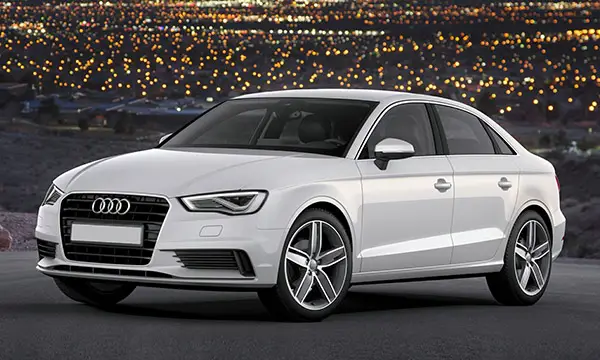
“The grass is always greener on the other side of the pond.” That’s the lament car enthusiasts in the U.S. have long uttered while gazing with intense longing across the Atlantic at the sports sedans, hatchbacks and wagons that seem much more numerous on European shores.
Over the past several years, however, a few of those cars have made it to our fair shores, among them the Audi RS 3, starting with just 250 preconfigured cars for the 2017 model year but continuing in earnest for the 2018 model year.
The RS 3 doesn’t arrive unopposed. Competitors like the BMW M2, Jaguar XE S and Mercedes-AMG CLA 45 come to mind. Compare the RS 3 with those cars here. Still, this is illustrious company. The M2 especially sets a high bar when it comes to driving dynamics and enjoyment, giving the RS 3 plenty to live up to. Even within Audi’s own stable, the TT RS two-door offers sharp handling, and the RS 7 sedan delivers face-melting acceleration (compare those here).
So it was with high expectations that I set out to see if the latest import from Europe has what it takes to be among this continent’s best.
How It Drives
Looking at the RS 3’s credentials on paper, it seems to have all the ingredients necessary for a raucous driving experience. Under the hood lies a 400-horsepower, turbocharged 2.5-liter five-cylinder that makes 354 pounds-feet of torque. An RS-tuned version of Audi’s Quattro all-wheel-drive system is standard, sending more power to the rear wheels than the Quattro system found on most Audis, and a seven-speed dual-clutch automatic is the only transmission.
Also uniquely tuned to the RS are its steering and Audi’s magnetic ride adaptive suspension, both with the goal of tightening up the driving experience. It works; the steering offers more weight and linearity than most Audis I’ve tested, and the suspension tightens up noticeably as you crank up the RS 3’s drive modes from Comfort to Auto to Dynamic.
I was prepared to love the RS 3, but there’s just something missing. Simply tossing all of a recipe’s ingredients into a bowl doesn’t give you a cake; all the components seem to be here, but the RS 3 lacks a sharpness I expect from a car with this price and pedigree. There are two reasons for this: body roll and a strange throttle delay.
The engine is powerful. The RS 3 wouldn’t be able to make its zero-to-60-mph sprint in less than 4 seconds (3.9, Audi says) without plenty of giddyup under the hood. The culprit to me is the transmission, which seemed to sap power when I wanted it most. Even with throttle settings dialed up to Dynamic, there was a strange hesitation to the acceleration that remained even when I tried shifting manually with the paddles. This delay was especially disconcerting coming out of corners, as I tried to hold momentum for the next turn and couldn’t quite get the car to agree with me.
Speaking of corners, there was also unexpected sloppiness from the RS 3 that sapped some of my confidence in pushing the car harder. It’s not that the suspension isn’t firm in its Dynamic setting — you do feel the road underneath you — there’s just a hint of vagueness when the car gets about midway through a curve that’s concerning. Combine this with a lack of burst on exit, and the RS 3 felt flat rather than sharp and responsive as expected.
Fuel economy is predictably bad for a small car, with an EPA-estimated 19/28/22 mpg city/highway/combined on premium gas. For comparison, Audi’s 186-hp A3 sedan is rated 29 mpg combined and takes regular. In between, the S3 sedan makes 292 hp and is rated 24 mpg combined with premium.
What I Tested
For 2017, the RS 3 has just one trim level, with a starting price of $55,450 (including a $950 destination charge). I tested a 2017 version of the car, which Audi says is identical to the 2018 other than the addition of blind spot warning and rear cross-traffic alert systems as standard equipment on the 2018. This bumps up the price slightly, so the 2018 model starts at $55,875.
Standard features include a panoramic moonroof, heated front seats, sport seats in Nappa leather, LED headlights and a backup camera. All 2017 RS 3s are preconfigured to add the Technology Package ($3,900) and Dynamic Package ($1,450), so you won’t find one at the base price. The Technology Package adds navigation, blind spot warning, rear cross-traffic alert, Audi Virtual Cockpit (which replaces the instrument panel with a large screen) and a Bang & Olufsen sound system. The Dynamic Package is more performance-focused, adding 19-inch wheels with a titanium finish, summer performance tires, red brake calipers and a sport exhaust system with black exhaust tips.
There were a few other single-feature options sneaking along for the ride on the car I drove, including carbon-fiber inlays on the inside ($600) and gorgeous Ara Blue crystal-effect paint ($1,075) on the outside. That paint job is worth singling out — it’s somehow even more sparkling blue than it appears in photos. I adored it. Final price as tested: $62,475.
Looks and Feels the Part
Despite sharing much of its shape with the more sedate A3 and S3, I found both the RS 3’s styling and interior to live up to its price and sporty aspirations. It shares prominent side skirts and a rear diffuser with the S3, but the grille gets a more prominent metallic rim, with “Quattro” spelled out in Audi font at the bottom. That particular cheeky, mildly cheesy touch probably won’t be universally loved, but I liked it.
The RS 3 is more practical than it may appear. It’s a small car, so passenger room isn’t abundant, but I did manage to carry four adults around for much of a day with no complaints, so long as the front and rear occupants negotiated legroom.
The quality of materials is a mixed bag: The seats are a highlight and the dashboard is a lowlight. The front seats feature an attractive diamond-stitched pattern on the backrests with contrasting gray thread, and they’re comfortable even for longer drives, which you can’t say about all sport seats. This high point is contrasted, however, by swaths of blankness on the dashboard. When you jump up from an A3 to an RS 3, you’re paying for speed, not better interior design.
The RS 3’s multimedia system comes with standard Android Auto and Apple CarPlay, though both systems are controlled via Audi’s controller knob, which takes some practice. The RS 3 I tested also had the optional Virtual Cockpit, which swaps out a conventional gauge-based instrument panel for a 12.3-inch color display, a feature I like a lot.
Value
For a car like this, value is inseparably tied to performance. If I’m spending $60,000-plus on a sports sedan, it better nail the “sport” part of that equation, and the RS 3 doesn’t quite do that. To be sure, it’s an athletic sedan that has plenty of engine and the ability to drive circles around 95 percent of cars out there. The problem is that the remaining 5 percent includes at least one of its closest competitors: I’d rather drive an M2, even if it can’t comfortably fit more than two people.
The RS 3 is also missing out a bit on safety features. I can understand features like adaptive cruise control and lane keep assist not coming standard on the A3, but that car is much cheaper. They’re available as part of a safety option package on the 2018 RS 3, and that’s hard to swallow given similar features are now standard on many cars with much lower price tags.
It would be unfair to say I didn’t enjoy the RS 3 or that it’s a bad addition to the menu of sport sedans here in the U.S. I think it’s a good car on its face; the problem is that, at this price, good doesn’t cut it — and the M2 is great.
Cars.com’s Editorial department is your source for automotive news and reviews. In line with Cars.com’s long-standing ethics policy, editors and reviewers don’t accept gifts or free trips from automakers. The Editorial department is independent of Cars.com’s advertising, sales and sponsored content departments.






























